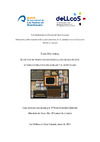Identificador persistente para citar o vincular este elemento:
https://accedacris.ulpgc.es/jspui/handle/10553/106433
| Título: | El método de traducción en películas de ciencia ficción: estudio contrastivo del doblaje y el subtitulado | Autores/as: | González Quevedo, Marta | Director/a : | Cruz García, Laura | Clasificación UNESCO: | 570112 Traducción 620301 Cinematografía |
Fecha de publicación: | 2021 | Resumen: | This dissertation is carried out in the field of Audiovisual Translation (AVT). More specifically, it focuses on dubbing and subtitling. Its main objective is to determine the degree of difference between the dubbed and the subtitled versions (from English into Spanish) of a corpus of science-fiction films. With this purpose in mind, a contrastive analysis of these two versions (dubbing and subtitling) is carried out in order to determine the nature and tendencies of the translation decisions in the field of AVT. When dealing with the translation of audiovisual texts (both for dubbing and for subtitling), the translator has to take into account a number of specific restrictions or “noise” (Mayoral, Kelly y Gallardo, 1988) that will determine his/her translation decisions. The concept of restriction can be defined as the text features which can make it difficult for the translator to produce a faithful translation of the source text. These specific restrictions are not always the same in both modalities. In fact, different restrictions can affect the translation of the dubbing and the subtitling versions. Therefore, through this study, we also expect to determine the current tendencies of translation solutions by analysing which translation techniques are the most frequently used to solve the dubbing restrictions and which ones are the most used to solve the subtitling ones. To achieve that, a wide number of samples from movies were studied through a methodology proposed by Martí Ferriol (2013), which consists of a descriptive analysis of the restrictions, norms and techniques used in the field of AVT. This research has a product-based approach, where the object of study is the target text (both the subtitled and dubbed versions in Spanish). Given that this methodology had only been applied to independent films from the United States, in this dissertation a completely different film genre was chosen, in order to prove the level of applicability of the method of analysis. The selected film genre was science-fiction due to the different characteristics that it presents compared to independent films, such as a wider target audience or a plot which is usually easier to follow. When choosing the specific movies that constitute the corpus, the release date, the nationality and the budget were also taken into account. The methodology consisted of selecting and tabulating extracts of the audiovisual text (the “samples”) where a significant difference between the Spanish dubbed and subtitled versions was found. After that, the samples were analysed and classified depending on the restriction present in the extract, and the norms and techniques applied by the translator. Finally, a study of the ocurrence of each one of these elements was carried out, to obtain some conclusions about their behaviour in science-fiction films. | Descripción: | Programa de Doctorado en Estudios Lingüísticos y Literarios en sus Contextos Socioculturales por la Universidad de Las Palmas de Gran Canaria | URI: | https://accedacris.ulpgc.es/handle/10553/106433 |
| Colección: | Tesis doctoral |
Visitas
826
actualizado el 03-feb-2024
Descargas
1.151
actualizado el 03-feb-2024
Google ScholarTM
Verifica
Comparte
Exporta metadatos
Los elementos en ULPGC accedaCRIS están protegidos por derechos de autor con todos los derechos reservados, a menos que se indique lo contrario.
